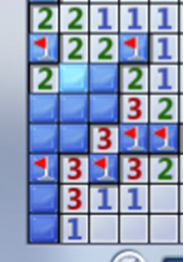A Minesweeper Probability Question

The above picture is the bottom-left corner of a Minesweeper game. We are given that there are 4 total bombs among the 9 untouched squares (1 light blue and 8 blue squares excluding those squares with a red flag).
Find the probability that the highlighted (light blue) square is a bomb. Assume that each possible arrangement of bombs is equally likely (with "possible" meaning it satisfies the given number clues).
Notes: (in case you're unfamiliar with Minesweeper)
-
The number on a white square represents the number of bombs adjacent to that square (including diagonally). These are squares which do not each have a bomb on them.
-
A red flag indicates a square where we already know there is a bomb.
-
Blue squares without a flag are "untouched," including the highlighted one. We are not given whether they have a bomb or not.
This section requires Javascript.
You are seeing this because something didn't load right. We suggest you, (a) try
refreshing the page, (b) enabling javascript if it is disabled on your browser and,
finally, (c)
loading the
non-javascript version of this page
. We're sorry about the hassle.
Let the positions of these unmarked squares be denoted as A , B , C , … , I as shown in the picture.
I will denote the value of 1 to a square with a flag/mine; and a value of 0 to a square without a flag/mine. For example, if B = 1 , then the top rightmost square has a mine.
Our mission here is to find the probability, P r ( A = 1 ) , given that precisely 4 of A , B , C , … , I has a value of 1, while the others has a value of 0.
We first partition the boxes as shown below and we will try to analyse each of these boxes separately.
For the top left pink box, looking at the left square of "2", we know that there should be precisely another 1 more mine among A , C , D .
For the top right orange box, looking at the right square of "2", we know that there should be precisely another 1 more mine among B , E .
For the bottom dark red box, looking at the top square of "3", we know that there should be precisely another 1 more mine among F , G , H .
Thus, from the 3 paragraphs above, we know that there are precisely 3 mines among A , B , C , … , H . So, one more mine is not used. And so, I must be a mine.
With I as a mine, then looking at the most bottom left square of "3" tells us that H cannot be a mine. So I = 1 , H = 0 .
Now, looking at the top square in the bottom dark red box tells us that precisely one of F and G is a mine only.
With all the given information above. Let us list out all possible scenarios for the remaining cells.
Case 1: If F = 0 , G = 1 , then D = E = 0 . This forces B = 2 ⇒ A = 0 ⇒ C = 0 , which is a possible scenario.
Case 2: If F = 1 , G = 0 , then precisely one of D , E is 0, while the other is 1.
Subacase 2.1: If D = 0 , then E = 1 ⇒ B = 0 ⇒ A = 1 ⇒ C = 0 , which is a possible scenario.
Subacase 2.2: If D = 1 , then A = C = 0 and E = 0 ⇒ B = 1 , which is a possible scenario as well.
Hence, all the 3 cases (inclusive of subcases) above are plausible. In all 3 scenarios, only one of the yields the solution of A = 1 . Our answer is 3 1 .